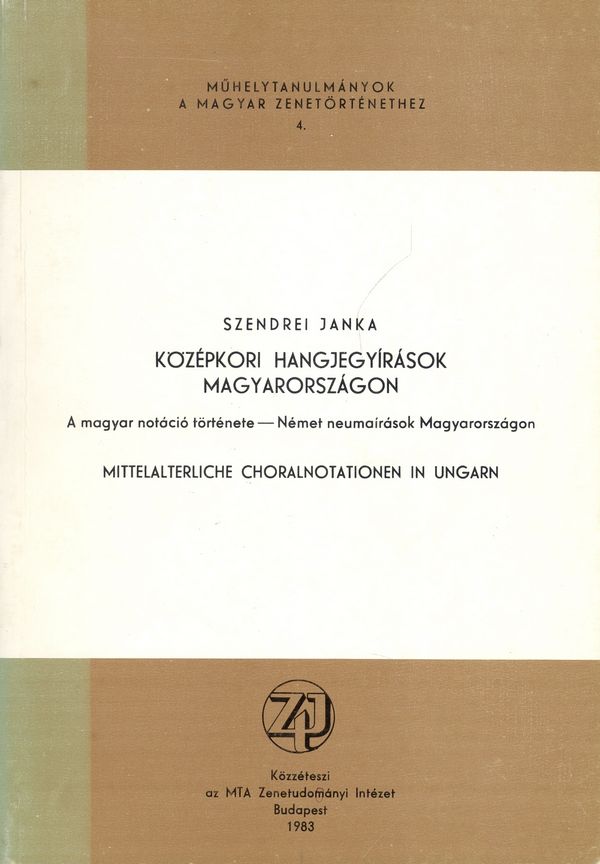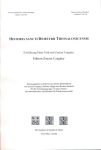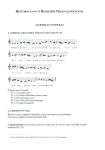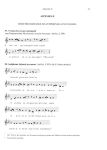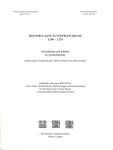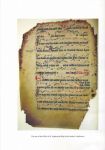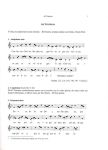Exhibitions in the Museum of Music History
Chant palaeography
- Chant palaeography is concerned with the forms of distinct plainchant notations found in medieval musical codices of the Catholic Church.
- Initial contributions from Hungary:
- 1922: Kálmán Isoz, Latin zenei paleográfia és a Pray-kódex zenei hangjelzései (Latin musical palaeography and the musical notation of the Pray Codex)
- 1950s: Zoltán Falvy, A Pray-kódex zenei paleográfiája (The musical palaeography of the Pray Codex, 1954)
- 1963: Zoltán Falvy and László Mezey, Codex Albensis. Ein Antiphonar aus dem 12. Jahrhundert (the first scholarly source publication from Hungary)
- 1960s onwards: parallel work by Kilián Szigeti, Benjamin Rajeczky, László Dobszay and Janka Szendrei
- Following detailed research by Janka Szendrei, there appeared in 1999 the first comprehensive history of Hungarian notation, centred on the history, characteristics and versions of Esztergom Notation, which she had identified.
- Further sources have appeared, mainly fragments of codices. Furthermore, research into Gregorian palaeography is being stimulated and continued in the Department as the study of fragments grows into a subject of strategic importance.
Post-Tridentine latin liturgical chant in Hungary
- After restricted beginnings, the first systematic, scholarly attempt began in 2008 to examine the last, declining period of Gregorian chant of Hungary. The task of fitting the work into the Department’s thematic framework has fallen mainly on Gabriella Gilányi.
- The main aim was to gather and explore the sources and analyse them in scholarly fashion. Basic research in some eight libraries and church collections in Hungary and abroad yielded several dozen notated sources, which were subjected to musical examination. Detailed descriptions of these were prepared.
- During the examination, large numbers of melodies were transcribed onto over a hundred cover sheets, to allow variants to be compared and analysed.
- Thematically the research became largely bipolar. Attention focused on (1) Hungary’s reception of the new post-Tridentine musical style and chant from Rome, and (2) survivals from medieval plainchant melodies.
- Remarkably rich source materials were found in the tradition of the Pauline Order, a Hungarian foundation. This enabled thorough examination and reconstruction of monodic Pauline singing practice of the 17th–18th centuries.
Medieval music theory
- In 1934, there appeared a classic monograph by Dénes Bartha on the school notes on music theory taken in 1490 by László Szalkai, later Archbishop of Esztergom.
- The book, which includes Szalkai’s text, remains the only major work in the country to deal with the theory of music.
- An international research group, Corpus Hollandrinum, was formed in 2002 to look into the 14th‒16th-century Bohemian, Polish, German and Hungarian texts on music theory and reconstruct from them the late medieval teaching-material and music theory traditions.
- The findings brought a fundamental change in the outlook of Hungarian research on music history. Although Szalkai’s notes were unprecedented in this country, they were not an isolated occurrence, but part of a late medieval, Central European tradition of tracts.
- It speaks for the Hungarian members of the research group that they managed to turn what had been seen only as a written tradition of music theory approachable by philological means into a subject of research in terms of music history, and reconstruct the liturgical plainchant practice in its background. This made it possible to discern the manifold, differentiated system of relations that lies behind the thinking on music theory and the late medieval practice of Gregorian chant. to deal with the theory of music.

GRADUALIA
- Its aim is to study the Mass chants and their liturgical arrangements in a comparative way.
- The project began in 2009, following the methods of CAO-ECE.
- Cf. Gábor Kiss, „Comparative Research into Medieval Mass Repertories”, in Papers read at the 15th meeting of the IMS Study Group Cantus Planus, Dobogókő/Hungary, 2009. Aug. 23–29, ed. Barbara Haggh-Huglo, Debra Lacoste (Lions Bay: The Institute of Mediaeval Music, 2013), 361–84.
- For the comparison the contents of the individual sources are listed according to a a unified system, in which the identification numbers always refer to the same (temporal and functional) point of the liturgy.
- Between 2009 and 2014 more than 100 sources were indexed, including the main corpus of the Hungarian tradition (ca. 40 sources).
- The indices of the sources can be viewed and compared in the following websites: www.zti.hu/earlymusic/gradualia/gradualia.html (2011); www.hunchant.eu (2013).

Historiae of saints
- This involves monographic treatment of the proprium de sanctis of individual Offices.
- Certain Office cycles may prove particularly interesting when large-scale reconstruction work on whole Office traditions, summaries of histories of sources and genres, or preparations are being made to publish certain sources. sanctis of individual Offices.
- Thin, condensed slices of the history of cantus planus may present and render conspicuous aspects which would remain hidden in a broader synthesis.
- Examination of the historiae of saints, which were seen initially as a research by-product, has developed into separate branch of the research.
- A fortunate conjunction took place in 1993 with the Historiae project in international plainchant research.
- So far three Hungarian volumes have appeared in the Historiae series of publications, two of them containing the Offices of Hungary’s two patron saints: St Stephen, King of Hungary, and St Demetrius of Thessaloniki.
The Department’s other main branch of research into the Divine Office, apart from exploration of all its traditions, concerns the hagiographic historiae of medieval Hungary and Central Europe. Its aims differ from those of the CAO‒ECE programme. In-depth analyses and monographic studies are done of the liturgical material for a sample of saints. The purpose is to trace the cult and the variant office cycles it produces, the forms in which its set of chants and melodies appear, and the routes by which they spread. This line of research has contributed for many years to the Historiae project coordinated by the Cantus Planus Study Group of the International Musicological Society.


